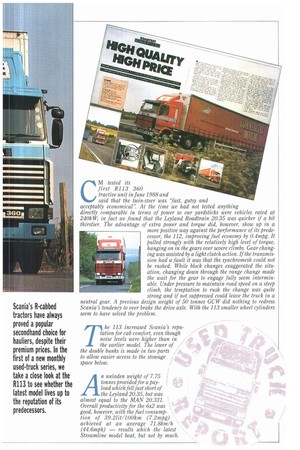C M tested its first R113 360 tractive unit in June
Page 33

If you've noticed an error in this article please click here to report it so we can fix it.
1988 and said that the twin-steer was "fast, gutsy and acceptably economical". At the time we had not tested anything directly comparable in terms of power so our yardsticks were vehicles rated at 240kW; in fact we found that the Leyland Roadtrain 20.35 was quicker if a bit thirstier. The advantage of extra power and torque did, however, show up in a more Positive way against the performance of its predecessor, the 112, improving fuel economy by 0,4mpg It pulled strongly with the relatively high level of torque, hanging on in the gears over severe climbs. Gear changing was assisted by a light clutch action. If the transmission had a fault it was that the synchromesh could not be rushed. While block changes exaggerated the situation, changing down through the range change made the wait for the gear to engage fully seem interminable. Under Pressure to maintain road speed on a steep climb, the temptation to rush the change was quite strong and if not suppressed could leave the truck in a neutral gear. A previous design weight of 50 tonnes GCW did nothing to redress Scania's tendency to over brake the drive axle. With the 113 smaller wheel cylinders seem to have solved the problem. 7111111-1 ...rod=UOLlh
















































































































